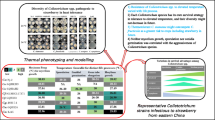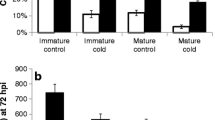Abstract
Phytophthora cinnamomi has recently been found in highly diverse and fragile alpine and sub-alpine environments previously considered P. cinnamomi and disease free due to low temperatures. In the laboratory, we investigated the ability of P. cinnamomi isolates to adapt to cold and cause disease under conditions comparable to alpine and sub-alpine environments. Initially, the ability of P. cinnamomi isolates to produce sporangia at 10 °C (2 °C lower than previously reported in the literature) was demonstrated in vitro. The lowest temperature limit for host infection was determined (i.e., 8 °C) and the phenotypic plasticity of isolates was then explored in planta in two successive phenotypic plasticity experiments comparing cold 9, 7.5 °C, and ambient temperature 25 (±5 °C). In the phenotypic plasticity experiment-1, three of the five isolates recovered from plants grown at 9 °C produced sporangia and released zoospores (infective propagules) at 7.5 °C, even lower than determined initially, i.e., 10 °C. No changes were observed in the same set of isolates recovered from plants grown at ambient temperature in the glasshouse as a control, which shows that P. cinnamomi can exhibit phenotypic plasticity and responds rapidly to selection pressure and adapts to new environments. Although P. cinnamomi isolates could produce infective propagules at 7.5 °C in vitro, they could not be recovered from inoculated plants grown at 7.5 °C after 3 months in phenotypic plasticity experiment-2. More work is, therefore, needed to establish disease development by P. cinnamomi at 7.5 °C and below.



Similar content being viewed by others
References
Bashi E, Rotem J (1974) Adaptation of four pathogens to semi-arid habitats as conditioned by penetration rate and germinating spore survival. Phytopathol 64:1035–1039
Burgess TI, Scott JK, McDougall KL, Stukely MJ, Crane C, Dunstan WA, Brigg F, Andjic V, White D, Rudman T, Arentz F, Ota N, Hardy GESJ (2017a) Current and projected global distribution of Phytophthora cinnamomi, one of the world’s worst plant pathogens. Glob Chang Biol 23:1661–1674
Burgess TI, White D, McDougall KM, Garnas J, Dunstan WA, Català S, Carnegie AJ, Worboys S, Cahill D, Vettraino A-M, Stukely MJ, Liew EC, Paap T, Bose T, Milgliorini D, Williams B, Brigg F, Crane C, Rudman T, Hardy GESJ (2017b) Distribution and diversity of Phytophthora across Australia. Pac Conserv Biol 23:150–162
Cahill DM, Rookes JE, Wilson BA, Gibson L, McDougall KL (2008) Phytophthora cinnamomi and Australia’s biodiversity: impacts, predictions and progress towards control. Aust J Bot 56:279–310
Chee K-H, Newhook F (1965) Variability in Phytophthora cinnamomi Rands. N Z J Agric Res 8:96–103
Crone M, McComb J, O'Brien P, Hardy GESJ (2013a) Annual and herbaceous perennial native Australian plant species are symptomless hosts of Phytophthora cinnamomi in the Eucalyptus marginata (jarrah) forest of Western Australia. Plant Pathol 62:1057–1062
Crone M, McComb JA, O’Brien PA, Hardy GESJ (2013b) Survival of Phytophthora cinnamomi as oospores, stromata, and thick-walled chlamydospores in roots of symptomatic and asymptomatic annual and herbaceous perennial plant species. Fungal Biol 117:112–123
Davidson AM, Jennions M, Nicotra AB (2011) Do invasive species show higher phenotypic plasticity than native species and, if so, is it adaptive? A meta-analysis. Ecol Lett 14:419–431
Dobrowolski M, Shearer B, Colquhoun I, O’brien P, Hardy GES (2008) Selection for decreased sensitivity to phosphite in Phytophthora cinnamomi with prolonged use of fungicide. Plant Pathol 57:928–936
Erwin DC, Ribeiro OK (1996) Phytophthora diseases worldwide. St. Paul, MN, USA
Garbelotto M, Rocca GD, Osmundson T, di Lonardo V, Danti R (2015) An increase in transmission-related traits and in phenotypic plasticity is documented during a fungal invasion. Ecosphere 6:1–16
Green K (2016) Dieback of Nematolepis ovatifolia (Rutaceae), an endemic shrub in the alpine- subalpine heaths of the Snowy Mountains, is facilitated by climate change. Cunninghamia 16:1–9
Halsall D, Williams J (1984) Effect of root temperature on the development of Phytophthora cinnamomi root rot in Eucalyptus seedlings. Aust J Bot 32:521–528
Holeski LM, Jander G, Agrawal AA (2012) Transgenerational defense induction and epigenetic inheritance in plants. Trends Ecol Evol 27:618–626
Hüberli D (2001) Phenotypic variation of two localised populations of Phytophthora cinnamomi from Western Australia and how they imact on Eucalyptus maginata resistance. Dissertation, Murdoch University
Hüberli D, Tommerup IC, Dobrowolski MP, Calver MC, Hardy GE (2001) Phenotypic variation in a clonal lineage of two Phytophthora cinnamomi populations from Western Australia. Mycol Res 105:1053–1064
Jung T, Colquhoun I, Hardy GSJ (2013) New insights into the survival strategy of the invasive soilborne pathogen Phytophthora cinnamomi in different natural ecosystems in Western Australia. For Pathol 43:266–288
Khaliq I, Hardy GESJ, White D, Burgess TI (2018) eDNA from roots: a robust tool for determining Phytophthora communities in natural ecosystems. FEMS Microbiol Ecol 94:fiy048
Khaliq I, Hardy GESJ, McDougall KL, Burgess TI (2019) Phytophthora species isolated from alpine and sub-alpine regions of Australia, including the description of two new species; Phytophthora cacuminis sp. nov and Phytophthora oreophila sp. nov. Fungal Biol 123:29–41
Kliejunas JT, Nagata J (1979) Phytophthora cinnamomi in Hawaiian forest soils: seasonal variations in population levels. Phytopathol 69:1268–1272
Laine AL (2008) Temperature-mediated patterns of local adaptation in a natural plant–pathogen metapopulation. Ecol Lett 11:327–337
Lowe S, Browne M, Boudjelas S, De Poorter M (2000) 100 of the world’s worst invasive alien species: a selection from the global invasive species database. Auckland, New Zeeland
Mariette N, Androdias A, Mabon R, Corbiere R, Marquer B, Montarry J, Andrivon D (2016) Local adaptation to temperature in populations and clonal lineages of the Irish potato famine pathogen Phytophthora infestans. Ecol Evol 6:6320–6331
McConnell M, Balci Y (2015) Fine root dynamics of oak saplings in response to Phytophthora cinnamomi infection under different temperatures and durations. For Pathol 45:155–164
McDougall K, Summerell B, Coburn D, Newton M (2003) Phytophthora cinnamomi causing disease in subalpine vegetation in New South Wales. Australas Plant Pathol 32:113–115
Nesbitt H, Malajczuk N, Glenn A (1979) Effect of soil moisture and temperature on the survival of Phytophthora cinnamomi Rands in soil. Soil Biol Biochem 11:137–140
Phillips D, Weste G (1985) Growth rates of four Australian isolates of Phytophthora cinnamomi in relation to temperature. Trans Br Mycol Soc 84:183–185
Podger F, Mummery D, Palzer C, Brown M (1990) Bioclimatic analysis of the distribution of damage to native plants in Tasmania by Phytophthora cinnamomi. Aust J Ecol 15:281–289
Pryce J, Edwards W, Gadek PA (2002) Distribution of Phytophthora cinnamomi at different spatial scales: when can a negative result be considered positively? Austral Ecol 27:459–462
Redondo MA, Boberg J, Stenlid J, Oliva J (2018) Functional traits associated with the establishment of introduced Phytophthora spp. in Swedish forests. J Appl Ecol 55:1538–1552
Rigg J, McDougall K, Liew E (2018) Susceptibility of nine alpine species to the root rot pathogens Phytophthora cinnamomi and P. cambivora. Australas Plant Pathol 47:351–356
Schild D (1995) The survival of Phytophthora cinnamomi Rands in the northern jarrah (Eucalyptus marginata Donn ex Sm.) forest of Western Australia. Dissertation, Murdoch University
Schlichting CD, Levin DA (1986) Phenotypic plasticity: an evolving plant character. Biol J Linn Soc 29:37–47
Shearer B (2014) Time course studies of temperature and soil depth mediated sporangium production by Phytophthora cinnamomi. Australas Plant Pathol 43:235–244
Shearer B, Shea S, Deegan P (1987) Temperature-growth relationships of Phytophthora cinnamomi in the secondary phloem of roots of Banksia grandis and Eucalyptus marginata. Phytopathol 77:661–665
Shepherd C, Pratt B, Taylor P (1974) Comparative morphology and behaviour of A1 and A2 isolates of Phytophthora cinnamomi. Aust J Bot 22:461–470
Simamora A, Stukely M, Barber P, Hardy G, Burgess T (2016) Age related susceptibility of Eucalyptus species to Phytophthora boodjera. Plant Pathol 66:501–512
Simamora AV, Paap T, Howard K, Stukely MJ, Hardy GESJ, Burgess TI (2017) Phytophthora contamination in a nursery and its potential dispersal into the natural environment. Plant Dis 1:132–139
Tokunaga J, Bartnicki-Garcia S (1971) Cyst wall formation and endogenous carbohydrate utilization during synchronous encystment of Phytophthora palmivora zoospores. Arch Mikrobiol 79:283–292
Weste G, Marks G (1987) The biology of Phytophthora cinnamomi in Australasian forests. Annu Rev Phytopathol 25:207–229
Zoete T (2000) Vegetation survey of the Barrington tops and mount Royal National Parks for use in fire management. Cunninghamia 6:511–578
Acknowledgments
We thankfully acknowledge Diane White and Bill Dunstan for the technical advice in the laboratory, and Keith McDougall for the detailed discussions.
Author information
Authors and Affiliations
Corresponding author
Ethics declarations
Conflict of interest
The authors declare that they have no conflict of interest.
Additional information
Section Editor: Marco Thines
Publisher’s note
Springer Nature remains neutral with regard to jurisdictional claims in published maps and institutional affiliations.
Electronic supplementary material
ESM 1
(DOCX 1252 kb)
Rights and permissions
About this article
Cite this article
Khaliq, I., Hardy, G.E.S.J. & Burgess, T.I. Phytophthora cinnamomi exhibits phenotypic plasticity in response to cold temperatures. Mycol Progress 19, 405–415 (2020). https://doi.org/10.1007/s11557-020-01578-4
Received:
Revised:
Accepted:
Published:
Issue Date:
DOI: https://doi.org/10.1007/s11557-020-01578-4




